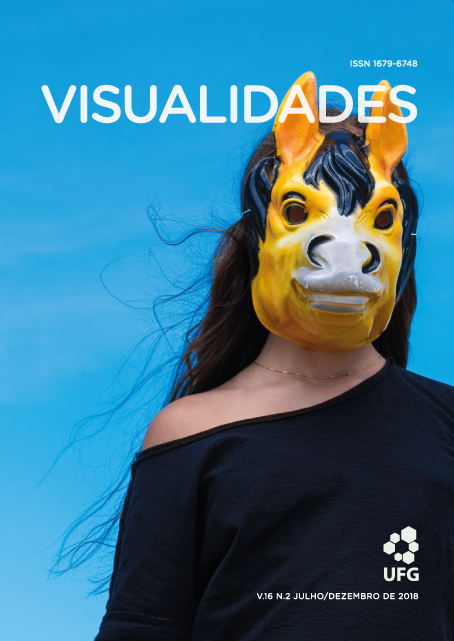Cenários do vácuo e o desaparecimento. Ausência e representação visual em Eco (Xacio Baño, 2015)
DOI:
https://doi.org/10.5216/vis.v16i2.56387Keywords:
Absense, Intimacy, SobrietyAbstract
Integrated into the movement of Novo Cinema Galego and taking part of its borderline characteristic, the film Eco constitutes an emotional and reflective representation of the concepts of emptiness, absence and disappearance. The reading on the screen of the mother’s diaries of one of the protagonists places this non-fiction sample as one of the most innovative strands of contemporary cinema: the expression of subjectivity and the external projection of certain aspects of intimacy. The film analysis tries to understand how images manage to, with the precision that characterizes them and an extreme formal sobriety, deal with the abstraction typical of emotions.
Downloads
References
Azalbert, N. (2013) Loin de Madrid: le cinéma galicien. Cahiers
du cinema. nº 693, 2013. 58-59.
Casetti, F. & Di Chio, F. (1994). Cómo analizar un film (2ª ed.).
Barcelona: Paidós.
Comolli, Jean-Lous (2007). Ver y poder. La inocencia perdida:
cine, televisión, ficción, documental. Nueva Librería:
Buenos Aires. P. 606.
Comolli, Jean-Lous; Sorrel, Vincent (2016). Cine, modo de empleo.
De lo fotoquímico a lo digital. Manantial: Buenos Aires.
Font, Doménec (2003). Michelangelo Antonioni. Madrid: Cátedra.
Font, Doménec (2012). Cuerpo a cuerpo. Radiografía del cine
contemporáneo, Barcelona, Galaxia Gutemberg.
Mamblona, Ricard, “Viajes de identificación personal en el
documental contemporáneo. De los autorreferencia a lo
personal”. En Marta Álvarez, Hanna Hatzmann, Inmaculada
Sánchez Alarcón (Eds.), No se está quieto. Nuevas
formas documentales en el documental hispánico, Madrid,
Iberoamericana, 2015, pp. 97-111.
Martínez Martínez, Isabel (2015). O cine de non ficción no Novo
Cinema Galego (2006-2012): conceptualización, contextos
e singularidades. Tesis Doctoral. Universidad de Vigo.
Facultad de Ciencias Sociales y de la Comunicación. Disponible
en: <http://novocinemagalego.info/wp-content/
uploads/2015/12/O_cine_de_non-ficcion_no_Novo_
Cinema_Galego-2006-2012.pdf > . Consulta: 18/12/2017.
Musicco Nombela, Daniela (2007). El campo vacío. El lenguaje
indirecto en la comunicación audiovisual, Madrid: Cátedra.
Pawley, Martin (2010). 2010: o ano do novo cinema galego,
Xornal de Galicia, 2 de xaneiro.
Paz Morandeira, Víctor (2016). Novo Cinema Galego: identidade
e vangarda, México D.F.: La Internacional Cinematográfica
/ Los Cuadernos de Cinema23.
Quílez, Laia (2008). “Sutiles pretéritos. (Post)memoria y (auto)
biografía(s) en el cine documental contemporáneo”En
Gregorio Martín Gutiérrez (edt.). Cineastas frente al espejo.
Madrid: T&B Editores.
Romero Suárez, Brais (2015): “Idioma e identidad en el Novo
Cinema Galego”. En Fonseca, Journal of Communication,
, 11, pp. 9-31.
Suárez, Pablo. “O Novo Cinema Galego. Galiza na senda da
vangarda”. En Madrygal. Revista de estudos galegos, 2014,
, pp. 123-130.
Downloads
Published
How to Cite
Issue
Section
License

This work is licensed under a Creative Commons Attribution 4.0 International License .
Authors who publish in this journal agree to the following terms:
a. Authors retain the copyright and grant the journal the right of first publication, with the work simultaneously licensed under the Creative Commons Attribution 4.0 License which allows the sharing of work with acknowledgment of authorship and initial publication in this journal.
b. Authors are authorized to take additional contracts separately, for non-exclusive distribution of the version of the work published in this journal (eg publish in institutional repository or as a book chapter), with acknowledgment of authorship and initial publication in this journal.
c. Authors are allowed to publish and distribute their work online (eg in institutional repositories or on their personal page) after the initial publication in this journal, as this can generate productive changes, as well as increase the impact and citation of the published work ( See The Effect of Free Access).
Every effort has been made to identify and credit the rights holders of the published images. If you have rights to any of these images and have not been correctly identified, please contact the Visuals magazine and we will publish the correction in one of the next issues.






